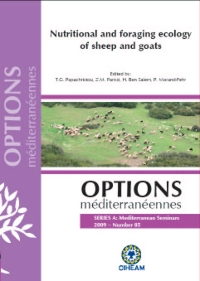| Article précédent | p. 405-409 | Article suivant |
Influence of supplementary feeding and the ram effect on conception rate of Barbarine ewes during spring mating
A total of 131 Barbarine adult ewes with an average live weight of 37 kg and an initial body condition score (BCS) of 1.25 were used. The ewes were allocated to treatment groups receiving two levels of supplementation during the 3 weeks prior to and the 4 weeks during mating. Ewes in treatment H were given a diet composed of 0.5 kg of hay and 0.5 kg of concentrate per ewe per day providing 130% of the metabolisable energy for maintenance (MEM) while ewes in treatment L remained underfed during this period and received each per day 0.2 kg of hay and 0.2 kg of concentrate representing 70% of the MEM. All the ewes were synchronised using intravaginal progestagen sponges left in situ for 14 days and were introduced to rams at sponges withdrawal. For each feeding regime, approximately half the ewes were artificially inseminated (AI) 24 hours after oestrous manifestation while the remaining ewes were allowed to mate naturally (NM). Ewes that did not hold to artificial insemination were allowed to naturally mate at the return of oestrus. During the first three weeks of application of the feeding regimes, ewes in all treatment groups lost weight and body condition: 36.85 ± 6.45 kg to 32.35 ± 4.64 kg and from 37.4 ± 4.4 kg to 34.4 ± 4.3 kg for the L and H treatments respectively (P < 0.05). BCS diminution reached 0.7 ± 0.57 and 0.59 ± 0.48 for ewes receiving the L and H treatment respectively. Neither the feeding regime nor the method of reproduction had a significant effect on fertility at the induced oestrus (36.4, 40, 30.8 and 31.3% for respectively ewes of the LNM, LAI, HNM and HAI groups). The method of reproduction had no effect on total fertility (51.5, 51.5, 64.7 and 67.7% respectively for ewes of the LNM, LAI, HNM and HAI groups). Levels of litter size were low in comparison to the breed mean values averaging 1.0 ± 0, 1.06 ± 0.24, 1.09 ± 0.29 and 1.09 ± 0.30 for respectively ewes of the LNM, LAI, HNM and HAI groups. It is concluded that for light ewes with a very low body condition that have endured several consecutive dry seasons, supplementary feeding for 3 weeks prior to and 4 weeks during mating coupled to stimulation by rams does not alleviate the negative effect of chronic poor feeding on fertility.
Un total de 131 brebis adultes d'un poids vif moyen de 37 kg et une note d'état corporel initiale de 1,25 ont été utilisées. Les brebis ont été réparties en deux lots selon le niveau alimentaire pendant 3 semaines avant et 4 semaines après la lutte. Les brebis du lot H ont reçu 0,5 kg de foin et 0,5 kg de concentré par tête et par jour apportant 130% des besoins d'entretien alors que les brebis du lot B ont continué à être sous-alimentées et ont reçu pendant la même période 0,2 kg de foin et 0,2 kg de concentré, ce qui correspond à 70% des besoins. Les brebis ont été synchronisées avec des éponges pendant 14 jours. Les béliers sont introduits le jour du retrait des éponges. La moitié des brebis de chaque lot est soumise à une insémination artificielle (IA) 24 heures après l'apparition d'oestrus. L'autre moitié est soumise à une lutte naturelle. Les brebis des lots IA sont saillies par les béliers au deuxième oestrus. Durant les 3 semaines d'application du régime, toutes les brebis ont perdu du poids vif et de la note d'état corporel (36,85 ± 6,45 kg à 32,35 ± 4,64 kg et de 37,4 ± 4,4 kg à 34,4 ± 4,3 kg dans les lots B et H respectivement, P < 0,05). La diminution de la note d'état corporel a été de 0,7 ± 0,57 et 0,59 ± 0,48 pour les brebis des lots B et H respectivement. La fertilité n'est affectée ni par le régime alimentaire ni par la méthode de reproduction. La fertilité à l'oestrus induit des 4 groupes était faible (36,4, 40, 30,8, 31,3% respectivement dans les lots BNM, BAI, HNM, HAI). La fertilité totale était de 51,5, 51,5, 64,7, 67,7 respectivement dans les lots BNM, BAI, HNM, HAI. La prolificité était faible dans les 4 groupes (1,0 ± 0, 1,06 ± 0,24, 1,09 ± 0,29, 1,09 ± 0,30 respectivement dans les lots BNM, BAI, HNM, HAI). En conclusion, une complémentation pendant 3 semaines chez des brebis légères et en mauvais état corporel suite à une succession d'années sèches, ne suffit pas pour pallier l'effet négatif de la sous-alimentation sur la fertilité.
- [ Afficher ]
- [ Télécharger ]
- [ Exporter la citation ]
Vous pouvez télécharger la citation au format :
- [ Imprimer ]
-
Mots-clés
ACCOUPLEMENT, BREBIS, FERTILITE, INSEMINATION ARTIFICIELLE, PERFORMANCE DE REPRODUCTION, SOUS-ALIMENTATIONCiter cet article
Lassoued N., Rekik M., Ben Salem H. Influence of supplementary feeding and the ram effect on conception rate of Barbarine ewes during spring mating. In : Papachristou T.G. (ed.), Parissi Z.M. (ed.), Ben Salem H. (ed.), Morand-Fehr P. (ed.). Nutritional and foraging ecology of sheep and goats. Zaragoza : CIHEAM / FAO / NAGREF, 2009. p. 405-409. (Options Méditerranéennes : Série A. Séminaires Méditerranéens; n. 85). 12. Seminar on: Nutritional and Foraging Ecology of Sheep and Goats, 2007/10/11-13, Thessaloniki (Greece). http://om.ciheam.org/om/pdf/a85/00801035.pdf



